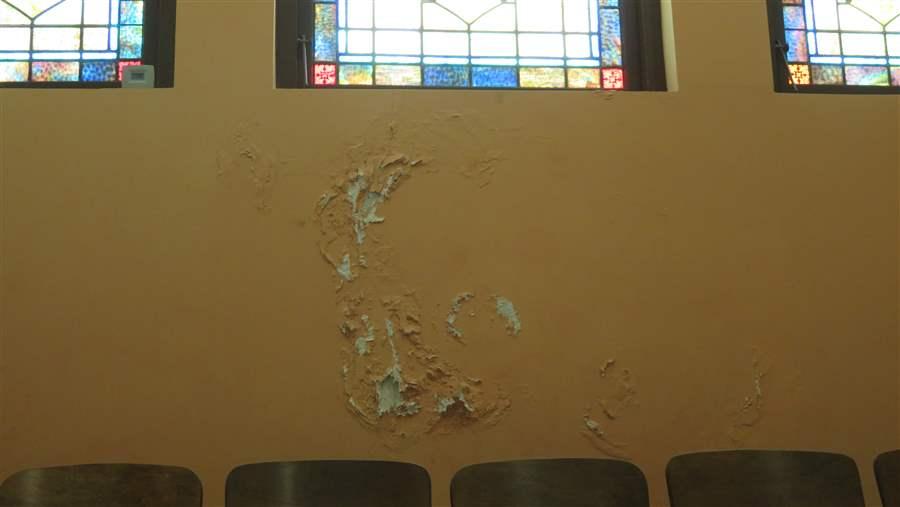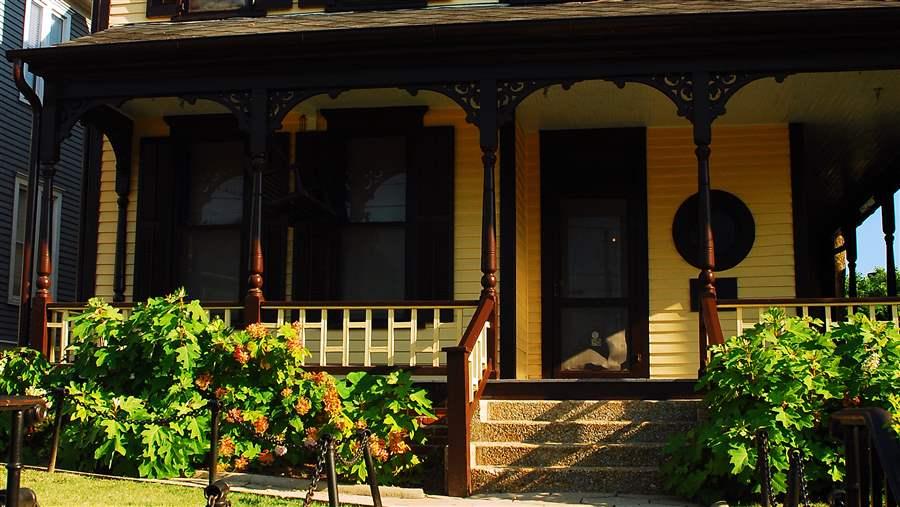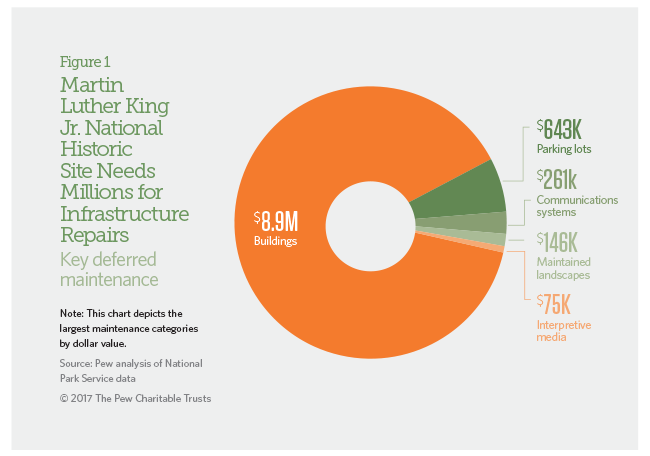Martin Luther King Jr. National Historic Site
Georgia
Pew created this case study using National Park Service deferred maintenance data issued in fiscal year 2015. The information listed here may no longer reflect the NPS site’s current condition or maintenance requirements. To find the most up-to-date information, please use the National Park Repair Needs tool.
Overview
At the Martin Luther King Jr. National Historic Site in Atlanta, visitors can explore some of the places that helped shape the civil rights leader’s life. The 38-acre park in the Sweet Auburn community, which includes the gravesites of King and his wife, Coretta Scott King, attracts more than 673,000 visitors annually.
During King’s childhood, Sweet Auburn was one of the most prosperous black communities in the United States. Visitors can walk the neighborhood’s streets and tour historic buildings, including King’s birth home and Ebenezer Baptist Church. King’s baptism, ordination as a minister, and funeral took place inside this red brick church, as did the 1957 meeting that launched the Southern Christian Leadership Conference. Today, nearly $10 million in repairs are needed to preserve these important landmarks.

The almost $10 million in deferred maintenance at the Martin Luther King Jr. National Historic Site includes painting the Ebenezer Baptist Church’s interior.
© The Pew Charitable Trusts
Maintenance challenges
The visitor center, where many begin their tour, houses exhibits that explain the civil rights movement. The building’s heating, ventilation, and air conditioning (HVAC) system, however, is outdated, and the exhibits are deteriorating, requiring $1.1 million for updates and repairs.
On Sweet Auburn Avenue, buildings such as the Ebenezer Baptist Church and King’s birth home—along with a series of shotgun houses—give visitors a sense of what the neighborhood looked like over 50 years ago. These structures need work, however. Water seepage has caused the church’s walls to crack and peel and its floors to buckle. King’s birth home, a late 1800s Queen Anne-style house, requires $193,000 to complete structural repairs to its subflooring. It was closed to the public for several months in 2016 and has partially reopened.
Water penetration, wood damage, leaky roofs, and outdated HVAC and fire alarm systems affect other buildings in the park, including the shotgun houses and Fire Station No. 6. All told, repairs to historic buildings account for $8.9 million of the park’s nearly $10 million in deferred maintenance.
To maintain some of its historic features, the park has partnered with the National Trust for Historic Preservation’s Hands-On Preservation Experience (HOPE) program, which trains youth in preservation crafts while helping to protect cultural sites on public lands. It also rents some of the buildings as homes to local residents. Although both initiatives are helpful, they are not enough to cover all the deferred maintenance, and more reliable funding from Congress is needed.
The Martin Luther King Jr. birth home is one of the most important sites in Atlanta and in national civil rights history. Its closure due to deferred maintenance was problematic for many reasons, first because visitors come from around the globe to see it, and secondly, it implies that our nation does not have the appropriate respect for the birthplace of an internationally significant figure.Mark C. McDonald, president and CEO, Georgia Trust for Historic Preservation
Recommendations
To address the deferred maintenance needs at the Martin Luther King Jr. National Historic Site and other National Park Service (NPS) sites in Georgia and across the country, Congress should:
-
Ensure that infrastructure initiatives include provisions to address park maintenance.
-
Provide dedicated annual federal funding for national park repairs.
-
Enact innovative policy reforms to ensure that deferred maintenance does not escalate.
-
Provide more highway funding for NPS maintenance needs.
-
Create more opportunities for public-private collaboration and donations to help restore park infrastructure.
Martin Luther King Jr. National Historic Site Facts
2016
| Visitor spending | $27.3 million |
| Jobs created by visitor spending | 454 |
| Economic output | $41.4 million |
| Labor income | $15.6 million |
| Visits | 467,715 |
| Deferred maintenance (fiscal year 2015) | $9.3 million |
Sources: National Park Service, “Annual Visitation Report by Years: 2006 to 2016,” accessed June 14, 2017, https://irma.nps.gov/Stats/ SSRSReports/National Reports/Annual Visitation By Park (1979 - Last Calendar Year); National Park Service, “Visitor Spending Effects,” accessed June 14, 2017, https://www.nps.gov/subjects/socialscience/vse.htm; National Park Service, “NPS Deferred Maintenance Reports,” accessed Aug. 19, 2016, https://www.nps.gov/subjects/plandesignconstruct/defermain.
© 2017 The Pew Charitable Trusts
The Pew Charitable Trusts works alongside the National Parks Conservation Association, the National Trust for Historic Preservation, and other national and local groups to ensure that our national park resources are maintained and protected for future generations to enjoy.
For further information, please visit: pewtrusts.org/nationalparks.














